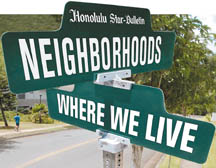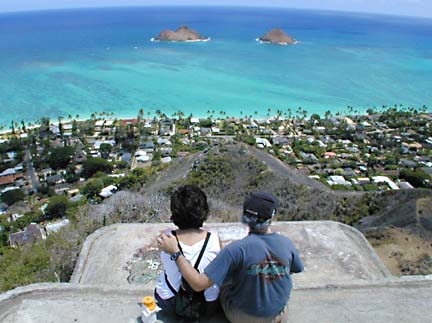
The northern fringe of the Koolaus and the deep blue sea hem in the community of Sunset Beach with few streets and homes mauka of Kamehameha Highway. Bike paths edge the two-lane road running "behind" homes as residents regard the sands that tilt along the shoreline as their "front yards."
Here, waves mark the neighborhood's identity -- gigantic waves that lure thousands of surfers every winter.
In Lanikai, ocean waves are the primary attraction, too, but they are deceptively lazy laps of aqua that eat away at the powdery sand year after year. Lanikai's appeal is its isolation. There's only one way in and one way out with Kaiwa Ridge guarding its back and Wailea Point at its southeastern flank.
Lanikai | Sunset Beach
BACK TO TOP |
KEN IGE / KIGE@STARBULLETIN.COM
Sharon Lennon, left, and her husband, John, enjoyed the view above Lanikai from an old bunker.
Seaside enclave
offers slice of heaven
Lanikai, a Windward neighborhood known for its world-class beach and million-dollar residences, was formerly a treeless patch of Japanese immigrant watermelon farms, and didn't have running water until the 1920s.
In 1924, advertising executive Charles Russell Frazier and associates bought about 300 acres of cloistered beachfront land off Kaiwa Ridge on the eastern end of Kailua Bay.
The real estate developers called the area Lanikai, which literally means "sea heaven." It was traditionally called Kaohao, or "the tying," from a legend about two women who were tied up and led away after losing a game to a Hawaiian chief.
A 1926 booklet advertised Lanikai as being "forty minutes from Fort Street," demarcated from within Kailua by the Lanikai Monument near Alala Point.
Frazier leased another 202 acres from Bishop Estate to establish the area's 18-hole Mid-Pacific Country Club, according to the club's history book.
Today, Lanikai has approximately 1,816 residents and 758 homes, according to the 2000 census. More than one-third of the households are rental units. Median household income was $79,197 in 1999. A little more than half the residents are in the labor force.
A landmark, the gray Hilltop House that peers out from the rocks above the Lanikai entrance, was built in 1931.
The entire neighborhood is a hodgepodge of older homes and run-down properties beside lush residences and the Bluestone townhouses on the golf course.
Mokulua Drive, which runs along the ocean side, is named for the Mokuluas, twin islands popular among recreational folk. One beachfront home, on 38,600 square feet of land, recently sold for $3.85 million, records show.
Lanikai's powdery white sand beach, dotted with visitors and locals on any given day, was named best in the United States by "Dr. Beach" Stephen Leatherman in 1996.
But beach erosion is a problem, which has been hastened by residents building sea walls to protect their properties. The city and state recently acted to replenish some of the world-famous sand, a temporary fix.
Another thorn is property crime, which increased 36 percent between 2000 and 2002, part of an islandwide trend, according to police statistics. Last year, there were 82 burglaries in that section of Kailua, compared with 48 in 2000. Auto theft and larceny have also increased by double digits in two years. Those numbers don't count unreported offenses.
Virginia "Gini" Enos, an eight-year Lanikai resident and Kailua businesswoman, said she joined the Kailua Neighborhood Board to address the recent rise in crime in Lanikai.
Enos said drug use appears to be a big part of the problem, as well as repeat criminal offenders.
"I moved here because it was a pleasant, safe, lovely community, and I just hate to see it go downhill," said Enos. "I don't want to see Lanikai get a bad name. There are a lot of vacation home owners, and they are stakeholders in this."
BACK TO TOP |
CINDY ELLEN RUSSELL / CRUSSELL@STARBULLETIN.COM
Lee Suratt sits with her grandchildren Sophia Miller, left, and Mia and Cru Suratt. Suratt, 80, moved to the area in 1949.
Neighborhood
tranquility prevails
until the waves are upEarly residents came to the district to get
away from it all and enjoy peace and quiet
Sunset Beach's allure is more than its world-renowned surf spots and white-sand beaches. Residents say it's all about lifestyle.
Tranquil country living is preserved in this North Shore neighborhood where people bicycle to the grocery store and walk to the beach -- far from busy downtown Honolulu.
Although Lee Suratt, 80, no longer surfs, she still enjoys swimming, strolling the beach and picking up shells for necklaces.
She and her husband settled here in 1949 to get away from it all. Oceanside lots were going for $6,000 to $7,000.
There was so little traffic, wild pigs would cross the highway, she said.
"Mom taught all of us, all the neighborhood kids, to fish and surf," said Suratt's son Brian, 51, a pro surfer turned surf instructor, who's raising his family there and his son is doing the same.
But quiet Sunset Beach metamorphoses into a surfer's haven when giant winter surf draws throngs of big-wave riders from places like Brazil, Japan and the mainland who stay for the season. But many never leave.
Legendary big-wave surfer Peter Cole was among a wave of mainland surfers to settle in Sunset Beach in the '60s. At 72, he still rides his 11-foot "gun" at Sunset, his favorite spot.
Mainland transplants outnumber those who grew up in the area.
"We all get along great," Cole said. "It's a lot different than Mililani. Everybody knows everybody."
But resentment of newcomers buying beachfront properties is growing.
A gated beachfront subdivision springing up in the area fronting Velzyland has some worried they'll lose their country lifestyle.
Community members have long opposed development. In the '90s the Save Sunset Beach Coalition fought rezoning agricultural land for a proposed 1,100-acre luxury home development, which was never built.
Real estate broker Elaine Niimi said there's not much real estate to begin with between the mountain and the ocean, and certainly not much left.
When she moved to the area 45 years ago to help her husband run his family's Niimi Store (opened in 1903), many beachfront houses were weekend homes.
"They were not an established community," she said.
"In the '50s it was just a few houses," said Ted Nakamura, 44, who was born and raised in Sunset. His parents came to Sunset to farm.
Nakamura grew up surfing, swimming and fishing and said there was little to do after sunset until 1974, the year TV came to Sunset Beach via cable.
Nakamura moved to town but said it felt good to return home in 1987 when Ted's Bakery, now a multimillion-dollar business, opened.
The bakery sits on the same location where his dad opened a fruit stand, which grew into a mom-and-pop store.
"I think the changes are good," he said, reflecting on Sunset's growth. "No people, no business."





